|
|
|

| The B-29-45-MO Superfortress named Enola Gay, Serial Number 44-86292, was a big attraction for aviation enthusiasts, the press, and peace activists. On August 6, 1945 the Enola Gay dropped an atomic bomb on Hiroshima, Japan. It was also an observation plane for the atomic bomb attack on Nagasaki, Japan. During the war the Enola Gay was assigned to the 509th Composite Group. After the war it served with the 393rd Composite Squadron. The Enola Gay was in open storage at Andrews AFB from 1959 until the National Air & Space Museum took it to the Paul E. Garber facility at Silver Hill, MD in 1965. The National Air & Space Museum began restoring the aircraft in 1984. The resotation cost almost $1 millon and 35,000 hours. In the 1990s the National Air & Space museum planned to display the Enola Gay's forward fuselage as part of a contextual display on the atomic bombings. The Air Force Association wrote some articles about the museum's plans. This snowballed into a large public outcry against the planned exhibit. The museum displayed the forward fuselage, and some other parts of the aircraft, in a much smaller exhibit than orignally planned. When that exhibit opened in 1995 there was a small protest on the steps of the National Air & Space Museum. There were a couple of vandalism incidents. The 1995 exhibit was one of the most popular of the Air & Space Museum's exhibits. The plan to exhibit the Enola Gay without context existed before the cancellation of the contextual exhibit in 1994. The B-29 program cost $3Billion, by comparison the Manhattan Project cost $2Billion. The US built over 3,700 B-29s Super Fortresses during World War II. The USAAF lost 417 B-29s during World War II to all causes. The USAF also used B-29s during the Korean Conflict. In Korea B-29s dropped 185,000 tons of bombs. The USAF credited the B-29s with shooting down 27 Communist aircraft during the Korean Conflict. Right is the Enola Gay at the Paul E. Garber Facility in the 1980s. Enola Gay crew member, then Lt. Morris R. Jeppson, who was the assistant weaponeer, died on March 30, 2010. Enola Gay Song |
 |
|
 |
An Aerospatiale/BAe Concorde. This Air France Concorde was the oldest Concorde in the Air France fleet. It made 6,967 flights and flew 17,824 flight hours. The Concorde began Paris-to-Dulles service in May 1976. A July 25, 2000 crash, which killed everyone on-board, caused the temporary grounding of the fleet. The Concordes did fly again however in 2003 Air France and British Airways, the only two airlines who were flying Concordes, stopped their Concorde service. The Concorde began its career in controversy. Residents near the airports complained about the noise. The Concorde wasn't a commercial success. On June 30, 1973 the Concorde prototype 001 flew a group of scientists over North Africa so they could observe a solar eclipse. On September 1, 1975 a Concorde became the first airplane ever to fly two return flights across the Atlantic Ocean in a day. |  |

|
Left: A P-47D, Serial Number 44-32691. The US Army Air Forces accepted this aircraft on October 27, 1944. It was flown to Godman Field, KY. The USAAF Museum Dayton, OH received the aircraft on January 27, 1946. The National Air & Space Museum acquired this aircraft in 1965. For years it was at the Smithsonian's Paul E. Garber facility at Silver Hill, MD. For much of that time it sported four ficticious kill markings. This aircraft spent World War II in the United States. The P-47 Thunderbolt was famous for its ability to absorb extensive combat damage and still continue flying. The P-47 had 8x50 caliber machine guns. This gave it more throw weight than any other day fighter in the USAAF's. It could fire 30.93 lbs (14.03kgs) of lead in a 3-second burst. P-47s flew their first combat mission on April 8, 1943. The USAAF credited the first P-47 victories on 15 April, 1943. The USAAF credited P-47s with three enemy aircraft shot down and one damaged. The P-47 losses were three aircraft with one damaged. The P-47 had its share of skeptics when they were first deployed. Some pilots viewed its heavy weight and high wing loading as making it too cumbersome to fight on equal terms with other fighters. It was more than twice as heavy as the Supermarine Spitfire VB. The USAAF credited the P-47 with a 4.6:1 Kill-to-Loss ratio in air-to-air combat. The USAAF credited the P-47 with destroying 7,000 enemy aircraft (both air and ground). The P-47s' last kill claim was on May 22, 1954 when Nationalist Chinese pilots Yen and Chen claimed a MiG-15. Right, a P-47 at the Andrews AFB Open House, May 2009. A P-47 was also at the Andrews AFB Joint Service Open House, May 2012. |  |
 |
The military version of the Boeing 707 is the C-135. A version of the C-135 is the E-3 Sentry. E-3s flew continuous operations over South West Asia for 13 years. Left is an RC-135 sporting the "Let's Roll" crest. Right is a C-135, tail number 26000, that served as part of the Presidential fleet, Andrews AFB, May 1998. Three KC-135s crashed during the Vietnam Conflict, none due to enemy action. |
 |
 |
An Arado AR 234B-2 Blitz, Werke Nummer 140312. The USAAF assigned this aircraft the number F.E. 1010 and later T2-1010. This is the only surviving Ar-234. The Ar-234 served in the reconnaissance and bomber role. There were experiments to use it in the night fighter role but there is no conclusive evidence it ever shot down an opposing aircraft. On the right is a picture of the AR-234 at the National Air & Space Museum in 1994 soon after its restoration. For more information about this aircraft read Luftwaffe Over Ohio. |  |
 |
An FW-190F-8 Wurger (Butcher Bird). This aircraft was originally an FW-190A-7 Werke Nummer 640069. It was damaged and then repaired as an FW-190F-8 Werke Nummer 931884. When the Smithsonian disassembled this aircraft they found it still had an explosive charge used to jettison the canopy. Right is a picture of this FW-190 at Udvar-Hazy Center in 2010. |
 |
 | The P-51 Mustang, called Excalibur III gained its fame after its military service. Pilot Paul Mantz used this aircaft to win the 1946 and 1947 Bendix Air Races. Paul Mantz also set a coast-to-coast speed record in 1947. Pilot Clinton Carney won second place in the 1948 Bendix Air Races. Herman Fish flew this Mustang to a third place finish in the 1949 Bendix Air Races. On January 31, 1951 this aircraft, piloted by Capt. Charles F. Blair, on a New York to London flight. This flight holds the speed record for a reciprocating-engine piston driven aircraft of 7 hours and 48 minutes. The Smithsonian Museum acquired this aircraft from Pan American Airlines on November 6, 1953. Right is a P-51 at the National Air & Space Museum in Washington, DC. The Mustang saw action in World War II, Korea, the 1956 War in the Middle East, and the "Soccer War" between Honduras and El Salvator. |
 Song Mentioning Mustang |
 |
A Hawker Hurricane Mk IIc, Serial Number LF686. This Hurricane was at RAF Bridgenorth in 1962. It was at the RAF Museum at RAF Colerne from 1965-1970. The Smithsonian acquired the aircraft in 1972. The RAF flew 906 Hurricane sorties over Dunkirk from May 27 - June 2, 1940. Right; the same Hurricane at the Paul E. Garber facility, April 1998. |  |
 |
The F8F Bearcat, Buff, Bu. Number Bu121646, Civil Registration Number N1111L. On August 16, 1969 this aircraft broke a 30 year speed record for piston engined aircraft. Its speed was 483.041mph. About 100 Bearcats served in Vietnam with the French and their allies. |  |
 |
The Space Transportation System Enterprise. NASA used this spacecraft as a testbed for the Space Transportation Fleet. The leading edge slats are missing because NASA is using them to investigate the Columbia disaster. NASA named this spacecraft Enterprise after a letter writting campaign by fans of the TV series Star Trek. Right is the STS Columbia at Kelly, AFB, TX in 1978. The STS Columbia stopped at Kelly AFB enroute to Cape Canaveral. It's strapped on a Boeing 747. The two chase planes are T-38s. |
 |
 |
An F-86 Sabre. Serial Number 8260. With almost 1,000 kills to their credit Sabres shot down more aircraft than any other jet. The Sabre made its combat debut during the Korean conflict. The Pakistani Air Force Sabre pilots also scored kills against Indian Air Force aircraft. Right an F-86 Sabre in Seoul, Korea, June 1991 |  |
 | A MiG-15 Fagot. The MiG-15 was originally given the NATO code name Falcon but it was considered too complimentary for an enemy aircraft. The MiG-15 first saw combat in the Korean Conflict. It also saw combat in the Middle East. Left is a picture of the Korean Freedom League's MiG-15 on outdoor display, August 1991. The picture on the right is the MiG-15 at the Udvar-Hazy Center at Dulles IAP, VA. |  |
 |
A MiG-21 Fulcrum at the National Air & Space Museum Udvar-Hazy Facility at Dulles IAP, VA. This MiG-21 is an export version. It was part of a USAF Soviet Awareness display before it was given to the National Air & Space Museum in 1992. MiG-21s served in combat in Indochina, The Middle East, The Balkans, The Indian Subcontinent, Africa, and Latin America. The picture on the left is from an Andrew AFB Open House, May 1995, while this MiG-21 was undergoing restoration. The name under the cockpit was Boris Badenov. Song: The MiG-21 by Dick Jonas |
 |
 |
Left: The F-4 Phantom Sageburner II at the Paul E. Garber Facility.
A total of 445 Phantom IIs were lost in the Vietnam Conflict, 382 of those were lost in combat. Enemy rocket barrages destroyed nine Phantom IIs on the ground. Besides the Vietnam Conflict F-4s have also served with the Israeli Air Force where they shot down 123 enemy aircraft. F-4s also served with the Iranian Air Force during the Iran-Iraq war. They also saw combat during Operation Desert Storm. During an attempted coup in The Philippines two USAF F-4s were sortied to prevent rebel units from using their aircraft to strike loyal positions. On June 23, 2012 Syrian forces shot down a Turkish Air Force RF-4E over the Mediterranean. The picture on the right is a Phantom II on static display at an airshow. |
 |
 |
A Luftwaffe F-4 38 21 of the Immelmann Geschwader, May 1996. |  |
 |
An SR-71 Blackbird at Andrews Air Force Base Circa 1985. The SR-71 was a Strategic Reconnaissance aircraft. This aircraft has the names Pilot; Maj. Jim Hansell, RSO; Maj. Tom Fuhrman, & E/C Roland Tite painted on its underside. In 1991 the smithsonian's SR-71 was dismantled and in storage crates at the Paul E. Garber facility at Silver Hill, MD. Two SR-71s were lost to mishaps during the Vietnam Conflict (64-17969 & 64-17978). Link to SR-71/YF-12 losses. |
 |
 |
This Westand Lysander Mk. IIIA is a new addition to the facility. It's manufacturer's number is 1185. It had the Royal Canadian Air Force number RCAF2346. Its owners included Ernie Simmons, Tillsonburg, Ontario; F. D. Emmorey, Montreal Quebec; Dolph Overton, Kenley, NC; Dwight Brooks, Van Nuys, CA. While in Van Nuys it was rebuilt with parts from RCAF2366. It was loaned to the USAF Museum at Wright-Patterson AFB, OH. Here it's displayed as N7791/AC-B. The picture to the right is of this airplane at the Paul E. Garber Facility in 1998. |  |

|
This He-219 was added in 2005. Left: Image links to an article about the NASM's He-219 and other He-219 information. The picture on the right is the He-219 at the Udvar-Hazy Center. For more information about this aircraft read Luftwaffe Over Ohio. |  |
 |
Dornier Do-335 Pfeil. Dornier carried out the initial restoration work on this aircraft. Right is the Do-335 in April 1998 at the Paul E. Garber Facility. For more information about this aircraft read Luftwaffe Over Ohio. |  |
 |
An Okha suicide plane. This aircraft, powered by a jet engine, is sometimes referred to as a Baka, the Japanese word for fool. The Okhas damaged 7 ships during the war. Left is the Okha at Quantico Marine Base, June 1989. |  |
 |
A Mid-Atlantic Air Museum Douglas R4D-6 Skytrain Tail number 50819, at Andrews AFB, MD, May 1998. Right a C-47, tail number 330652 with D-Day Invasion stripes, at Andrews AFB. |  |
 |
The C-54, Spirit of Freedom |  |
 |
Left, a Mid-Atlantic Air Museum B-25J Mitchell Tail Number 43-27638, at Andrews AFB, MD, May 1998. Right, a B-25 nicknamed "Panchito" at Andrews AFB, May 2004. Panchito also appeared at a Joint Base Andrews Open House |  |
 |
An F-14 Tomcat of VF-41, The Black Aces at the Andrews AFB Open House 2000. In 1981 two F-14s from this Squadron shot down two Lybian Su-22s. U.S. Navy F-14s shot down two Lybian MiG-23s in 1989 and a helicopter during Operation Desert Storm. U.S. Navy F-14s also destroyed three enemy aircraft on the ground and a U.S. helicopter so it wouldn't fall into enemy hands. F-14s destroyed over 40 armored vehicles and 30 artillery pieces. An F-14 scored a direct hit on an Iraqi Communications facitity during Operation Desert Fox. On the last F-14 deployment they flew 6,876 flight hours, flew 1,163 combat sorties, dropped 9,500 pounds of bombs. Right is an F-14 performing at an Andrews AFB Open House 1998.
|
|
| Left A B-17 takes off at Andrews AFB, MD. |
 |
|
 |
A Sikorsky CH-54 Tarhe over Staten Island, NY, July 1990. |  |
| Left a C-141B at Andrews AFB, MD, May 1993. Right a C-141B at Andrews AFB, MD, May 1990. Two C-141As were lost in Vietnam through mishaps. Serial Number 65-9407 was destroyed in a collision on the runway in Danang with a USMC A-6 on 23 March 1967. Five of the six crew members were killed in the mishap. On April 13, 1967 serial number 66-0127 crashed on takeoff at Cam Ranh Bay, killing 6 of the 8 crew members. |  |
|
 |
During Operation Desert Storm F-111s destroyed 949 AFVs, 252 artillery pieces, 243 aircraft shelters, 4 aircraft on the ground, 2 ships, and numerous other targets. Right is an F-111 at the Andrews AFB Open House, 1987. During the Vietnam Conflict 11 F-111s were lost, 6 in combat. The first in loss in the Vietnam conflict, aircraft serial number 66-0022, was on March 28, 1968. The loss was due to mechanical failure. The two crew members,Major Henry McCann and Captain Dennis Graham, were killed. The final loss in the Vietnam conflict was due to a mid-air collision over Cambodia. The crew was rescued. The incident happpened on June 16, 1973. An Aardvark was shot down by ground fire during the raid on Lybia in 1986. An Iraqi Mirage F-1 scored an ACM kill against an EF-111 during Operation Desert Storm. |
 |
 |
Left; An A-37 dragonfly at a Randolph AFB Open House, May 1979. Right; A T-37 on display at Medina AFB. A total of 22 A-37s were lost during the Vietnam conflict. |  |
| For more information about this aircraft read Luftwaffe Over Ohio. Right an Me-163 Komet at the Air Force Museum in Dayton, Ohio. AF Museum photo by Paul Straney |  |
|
 |
Left: A Nakajima Kikka Orange Blossom at the Paul E. Garber Facility, Silver Hill, MD, April 1987. Right: The same Kikka at the Paul E. Garber Facility, Silver Hill, MD, April 1990. | 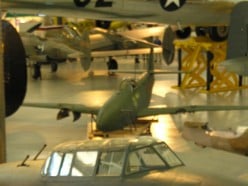 |
 |
An Arado Ar-196 at the Paul E. Garber Facility, Silver Hill, MD. This Ar-196 served on the Prinz Eugen. Left from April 1988, Right from April 1998. |  |
 |
A Bachem 349B "Natter" at the Paul E. Garber Facility, Silver Hill, MD, April 1988. Right: The same Natter at Silver Hill 1998. For more information about this aircraft read Luftwaffe Over Ohio. |  |
 |
An F-102 at the Lackland AFB Museum, 1977. Right: An F-102 at Medina AFB, TX, circa 1980. |  |
 |
A New Jersey ANG F-106, Serial Number 90047 at Andrews AFB in the early 1980s. Right: An F-106 Serial Number 90082, Randolph AFB circa 1982. |  |
| A Macchi MC202 Folgore at the National Air & Space Museum, Washington, DC, June 1989. Serial Number MM9476. When it was captured it was given Foreign Evaluation number FE-498. |  |
|
 |
An A-1, Bu No 132261, at Quantico Marine Base, June 1989. Right: An A-1 Skyraider at the Paul E. Garber facility July, 1983. In Vietnam the USAF lost 191 Skyraiders, 150 to enemy action. The first loss was an A-1E belonging to the 1st Air Commando Squadron, 34th TG, serial number 52-132465. It was shot down in South Vietnam on the night of 28-29 August 1964 near Bien Hoa. The last Skyraider lost was an A-1H of the 1st Special Operations Squadron, 56th Special Operations Wing, serial number 52-139738. It was shot down 28 September, 1972 the pilot was rescued. |  |
 |
An F-20 Tigershark at the Randolph AFB Open House, May 1985. A short time later this aircraft crashed at an Airshow in Seoul, killing the pilot. |  |
 |
Left: An F-6 Skyray, Bu No 139177, at Quantico Marine Base, June 1989. |  |
 |
An F3D Skyknight, at Quantico Marine Base, June 1989. | |
 |
Left: A Dauntless, at Quantico Marine Base, June 1989. Right: A Dauntless at the Marine Corps Museum. |  |
 |
Avenger photos at Dulles IAP. |  |
 |
A Consolidated Catalina at Andrews AFB, May 1990. Right: a Catalina at Andrews AFB, May 1991. |  |
 |
An HU-16 Albatross Photo by Mike Marshall. Four HU-16s were lost during the Vietnam Conflict:
|
 |
 |
A Mosquito at the Paul E. Garber Facility, April 1991. | |
 |
An He-162 at the Paul E. Garber Facility, April 1991. For more information about this aircraft read Luftwaffe Over Ohio. |  |
| The last flying He-111 at an open house, Leesburg Airport, VA, August 2000. This plane crashed on July 10, 2003. The pilot and co-pilot, the only two people on board, died in the crash. The unoccupied building the plane crashed into was also destroyed. Right: Same aircraft, different place. Photo by Mike Marshall. |  |
|
 |
An F4U-5NL Corsair at the Dulles IAP 2007 Annual Plane Pull. This Corsair, Bu. No. 124692, has a radar pod for night fighting. bottom left is a picture of its radar from the 2010 Plane Pull. Right is an F4U-4 Corsair, Bu. No. 81415, on Yoido Island, Seoul, Korea, June 1991. |  |
 |
An A-4 Skyhawk, Bu no 62153, at Fort Wadsworth, Staten Island, New York. Right: A Skyhawk at Andrews AFB. The A-4s served in Vietnam, the Middle East, and in the Falklands. Article |
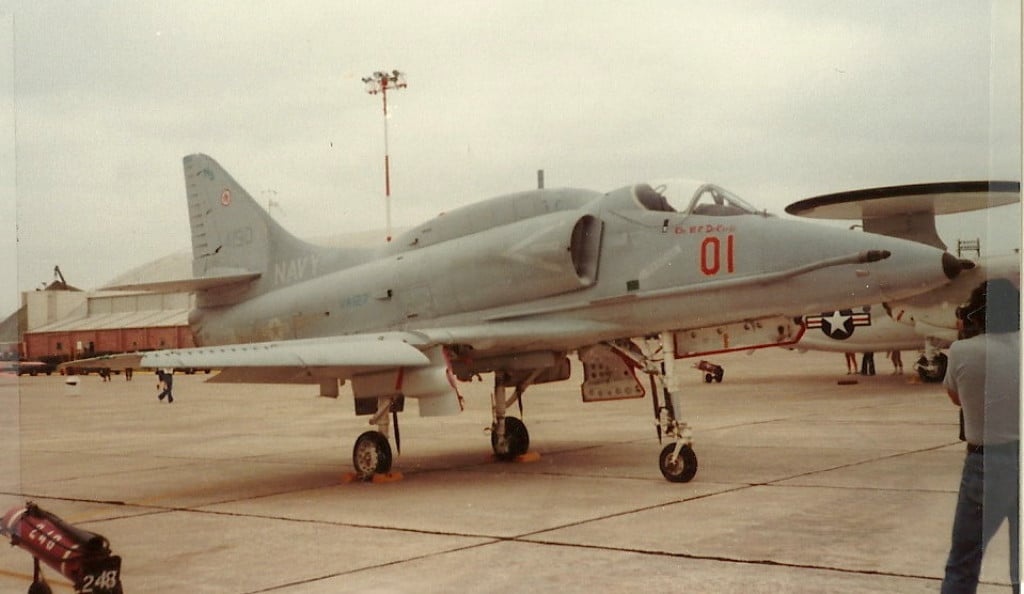 |
| F-104 Starfighter at Andrews, AFB, May 1997. A total of 14 Starfighters were lost in the Vietnam Conflict between 1965 & 1967, nine of these were combat losses. The F-104 also served with the Pakistani Air Force during their 1971 war with India. The Starfighter Song |
 |
|
 |
Left, a Hudson at Andrews, AFB, May 1992. Right, a Hudson at Andrews AFB, May 2000. Link to Paul Strany's Hudson page. |

|
 |
Left: F-105, tail number 00445 at the Dulles Annex. Right: F-105, tail number AF56-440, at Paul E. Garber, April 1990. A total of 382 Thunderchiefs were lost in the Vietnam Conflict, 320 in combat. The first loss was in August 14, 1964. The F-105D, serial number 62-4371, returned to base but was written off because of the battle damage. The final Thunderchief lost in combat was an F-105G, serial number 63-8359. It was shot down by a Surface to Air Missile (SAM). The crew was rescued. Thud Pilot by Dick Jonas |
 |
 |
The Ho-229 V3 at the Paul E. Garber facility, April 2000. For more information about this aircraft read Luftwaffe Over Ohio. |  |
 |
A Tank Ta-152H at the Paul E. Garber Facility, 1998. For more information about this aircraft read Luftwaffe Over Ohio |  |
 |
The F-117s retired on March 11, 2008. An F-117 at Andrews AFB. |  |
 |
Left: The B-24 named, Diamond Lil, Serial Number N24927. Right: A B-24 at Manassas Airport, Virginia. The Diamond Lil was also at the Andrews AFB, 2012 Open House. |
 |
 |
Left, a P-26 Peashooter at the Dulles Annex. Right, the same P-26 at the Paul E. Garber facility, April 1998. |  |
 |
Left a C-121, tail number 0-40177, at the Dulles Annex, 2009. Right a C-121 at Freedom Flight America, August 1995. Two EC-121s were lost in the Vietnam Conflict:
|
 |
 |
Left: a P-61 Black Widow at the Dulles Annex, 2009. Right: The same P-61 at the Paul E. Garber facility, 1998. |  |
 |
Left: A U.S. Navy Loon, a first generation cruise missile modeled after the German V-1, Buzz Bomb. Right: A Loon at Lackland AFB, Texas, 26 April 1979. |  |
 |
Left: A German V-1, Buzz Bomb at the National Imperial War Museum, Duxford, UK. Right: A V-1 at The National Air & Space Museum, Washington, DC |  |
 |
A night fighter version of the Japanese Kowasaki Ki-45 at the Dulles Annex. Right, nose of the Ki-45. |  |
 |
Canadian T-33 at Andrews AFB, MD. |  |
 |
An F-80 Shooting Star at Lackland AFB, June, 25, 1977. | |
 |
A T-28B, Bu. No. 140035 civil serial number N281CM, at Dulles IAP. A total of 23 T-28s were lost by the USAF during the Vietnam Conflict. |  |
 |
A T-2 Buckeye at Andrews AFB, May 1996. | |
 |
A Bf-108 at Andrews AFB, May 1996. The Bf-108 had a long postwar career in movies. In many movies, such as Von Ryan's Express & The Longest Day Bf-108s played the part of Bf-109s. | |
 |
A bf-109 at the Smithsonian, Washington, DC, June 1999. Me-109 Lied |
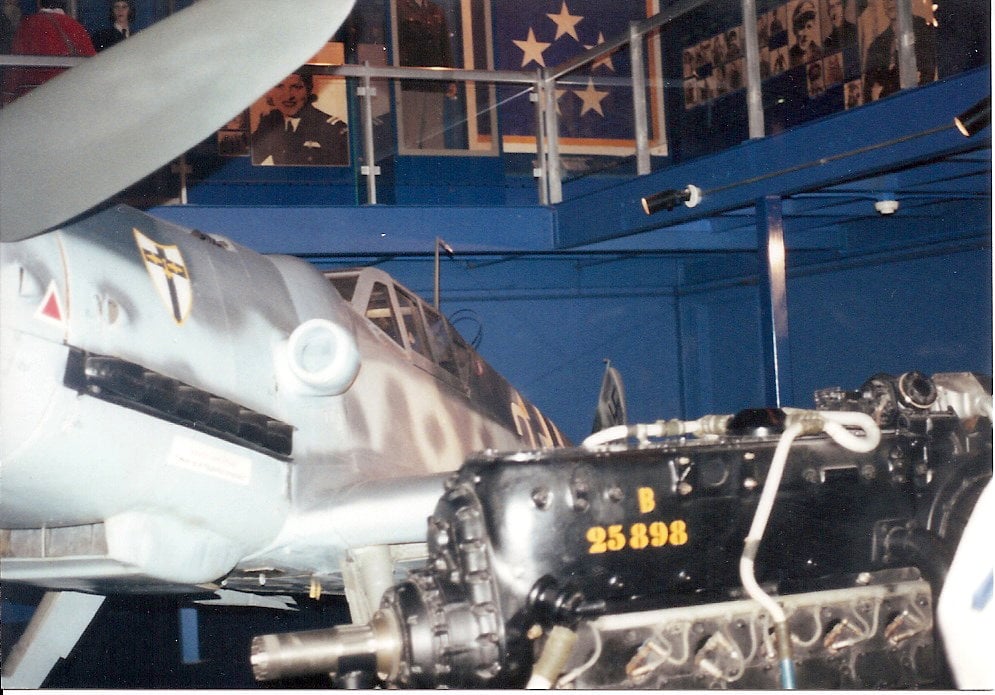 |
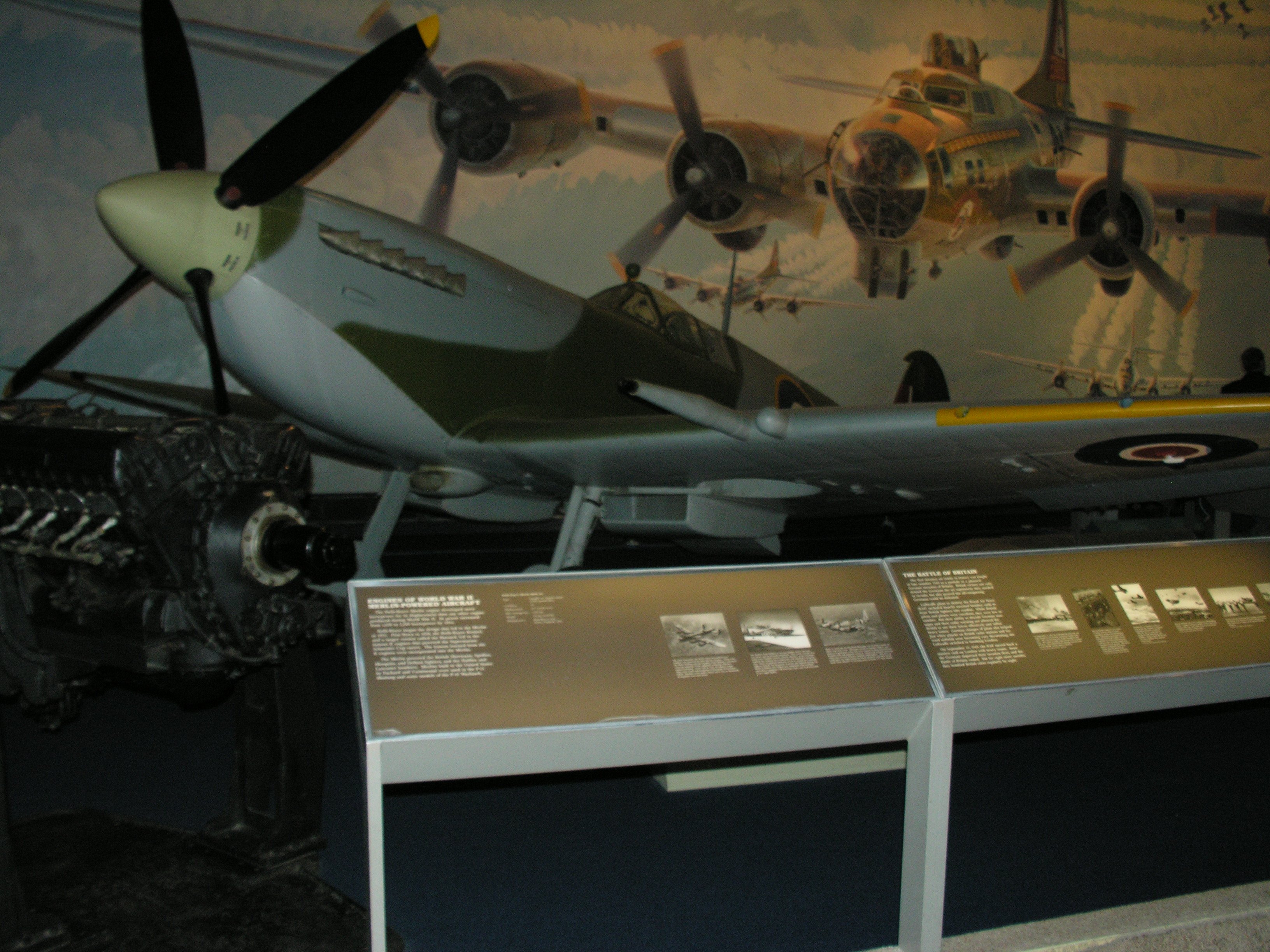 |
A Spitfire Mk VII, EN474, at the National Air & Space Museum, Washington, DC 2000. |  |

|
A P-38 at the NASM Dulles Annex, March 2005. | |
 |
Left: A P-39 at the Paul E. Garber facility. Right: A P-63 at Lackland AFB, TX, 1977. |  |
 |
The Invader probably has the distinction of the aircraft with the most confusing designation number. When it first entered service it was given the designation B-26, the same designation as the World War II era Marauder. The Invader's designation number was changed to A-26 in the 60s. The Invader served in the Korean and Vietnam conflicts. During the Korean conflict it was credited with some air-to-air kills. Left: An A-26 Invader at Yoido Island, August 1991. Right: An A-26 at the Paul E. Garber Facility, April 1998. A total of 22 Invaders were lost in Vietnam. The first Invader loss a B-26B of Detachment 2A, 1st ACG, Serial Number 44-35530. It was shot down in IV CTZ on the night of 4-5 November 1962. All Three crew members were killed. The last Invader loss an A-26A, 609th SOS, 56th SOW, Serial Number 64-17646. It was shot down over Laos on the night of 7-8 July 1969. Both crew members were killed. | |
 |
Right: An F-100 at the Paul E. Garber facility in April 1998. A total of 243 F-100s were lost in the Vietnam Conflict, 198 in combat. |  |
 |
An Me-410 at the Paul E. Garber Facility, April 2000. For more information about these aircraft read Luftwaffe over Ohio. | |
 |
This is not Roswell, NM. This is Silver Hill, MD, April 1998. This is the Voight V-173, often called the flying pancake or flying flapjack; presumably depending on which region of the country you're from. If you saw a UFO in Connecticut in the mid-1940s this may be what you saw. | |
 |
A Bü 181 at the Paul E. Garber Facility. For more information about these aircraft read Luftwaffe over Ohio. |  |
 |
A Mitsubishi Zero at the National Air & Space Museum, Washington, DC, Winter 2000. |  |
 |
A Kawanishi N1K2-Ja Shiden Kai "George" at the Dulles Annex, June 4, 2010. | |
 |
The Messerschmidt Me-262 at the National Air & Space Museum, Washington, DC. Me-262 by Blue Oyster Cult |
 |
 |
Left: A Fi 156 Fieseler Storch at the Paul E. Garber facility, April 1998. Right: A CAF Fi 156 at Hondo, Texas, circa 1980. |  |
 |
A Ju-87 Stuka at the Museum of Science and Industry, Chicago. Wikipedia |  |
 |
A Ju-388 at the Paul E. Garber facility, June 1998. | |
 |
A Pfalz D XII at the Paul E. Garber facility and the National Air & Space Museum, Washington, DC. |  |
 |
An RAF Vulcan bomber at the Randolph AFB Air Fiesta 1982. |  |
 |
A Hawker Tempest of the Confederate Air Force at Hondo, Texas late 1970s. |  |
 |
Left: An SB2-C Helldiver taxis after landing, circa 1995. Photo by Mike Marshal Right: An SB2-C at the Udvar-Hazy Center, Dulles, VA |  |
 |
An F-82, FQ-262, at Lackland AFB, April 6, 1977. F-82s made the first air-air kills of the Korean Conflict. | |
 |
The last flight for a UK Nimrod took place on March 31, 2010. Nimrod Squadron 51 Squadron earned the Battle Honor IRAQ 2003 with right to emblazon. December 22, 2003 - An RAF Nimrod supported an operation that captured 2 dhows that were smuggling drugs. Flew Northern Watch missions. June 2007 - RAF Nimrods flew missions to access the impact of Cyclone Gonu Two RAF R1s started flying recce missions over Afghanistan on October 9, 2001. RAF Nimrods flew reece missions over Somalia. Nimrods flew missions during the Kosovo operation. September 2, 2006 - A Nimrod crashed and killed all 14 on board. |
|
 |
A Grunau Baby II B-2 at the Udvar-Hazy Center. |  |
 |
A Grumman F7F-1 Tigercat, circa 1995. Photo by Mike Marshal | |
 |
A Sikorsky S-55 Bu No. 127834 |  |
 |
The Focke-Achgelis FA 330 Bachstelze Wagtail at the Steven F. Udvar-Hazy Center, June 6, 2010. |  |
 |
Left: A P-40 at the Dulles Annex, 2003. Right: A P-40 at Andrews AFB, MD, May 19, 2012. |  |
 |
Left: A Bell Iroquois at Ft. Sam Houston, TX, May 1980 Right: A Bell Iroquois at Hondo, TX, 1980. |
 |
 |
August 2014 - EA-6Bs flew missions against ISIL forces. March 11, 2013 - An EA-6B Prowler assigned to the Electronic Attack Squadron 129 crashed 50 miles west of Spokane, Washington. The crash killed Leutenant Junior Grade Valerie Cappelaere Delaney, Lieutenant Junior Grade William Brown McIlvaine III, and Lieutenant Commander Alan A. Patterson. February 12, 2008 - EA-6B Prowler assigned to Electronic Attack Squadron 136, part of Carrier Air Wing 5, crashed near Andersen AFB, Guam. All four crewmen ejected safely. |
 |

|
A Nakagima J1N1 Gekko (Moonlight) at the Udvar-Hazy Center. |  |

| Luftwaffe Tornadoes at Andrews AFB, May 1996. | 
|
 |
Left, an Antonov An-2 Kukuruznik in Seoul, Korea, 1991. Right, an An-2 at the Paul E. Garber Facility, Silver Hill, MD, April 1992. |  |
 |
Left: A C-2 over Washington, DC during the Desert Storm Victory Parade, June 1991. Right: A C-2 on display at Andrews AFB, MD |  |
 |
KC-10s on display at Andrews AFB, Maryland. |  |
 |
Left: A Boeing 727 of the U.S. Postal Service. Right: An Air Force version of the Boeing 727. Andrews AFB, MD |  |





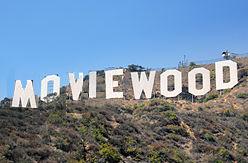






Send questions or comments to: Robert Sacchi